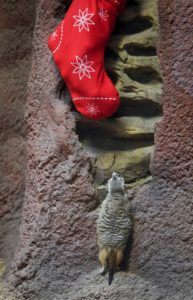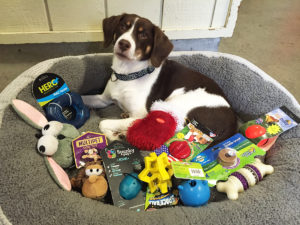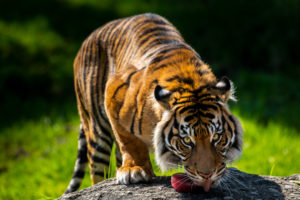
Inspired to give your own pet an enriching treat these holidays?
“Enrichments are a big part of caring for an animal,” explains Sara Mattison, staff biologist at the Wild Wonders Outdoor Theater and chair of the Enrichment Committee at Point Defiance Zoo & Aquarium. “They give mental and physical stimulation, and encourage natural behaviors that are good for any animal.”
Keepers in Kids’ Zone like to give their meerkats a holiday stocking surprise, filled with wiffle balls and mealworms.
But what kind of enrichment is best? We asked Mattison for some advice, and she came up with three main points: safety, quality and behavior.
Safety First
“Safety is the most important thing when we think about animal enrichments,” says Mattison. She’s sitting inside the enrichment room at Wild Wonders, which is lined with shelves full of clear tubs labeled “Feeders,” “Soft items,” “Bones” and so on. Every single item is listed in a database, and every single one has been vetted by at least four people (keeper, veterinarian, senior staff biologist and curator) for safety and appropriateness to the individual animal.
“Think about the material – is it something that could be ingested or cause entanglement?” explains Mattison. “Are there holes? If so, could a paw or nose get stuck? Could the animal break off chunks? And when you first give your pet an enrichment, supervise closely to make sure it is safe.”
Quality Food

Next comes quality – of the item, but also of any food treat inside.
“If you give treats, they should be as good or better quality as the animal’s regular diet,” Mattison says. “Smaller specialty pet stores can give you advice on high-quality food. And our rule at the Zoo is that treats should make up only 5% of the daily diet. Think of it like a dessert.”
There are many puzzle feeder toys available for purchase, especially for dogs – the red or black rubber ones are a good place to start. But even giving a daily diet in new ways can be enriching.
“Sprinkling your dog’s kibble into an ice tray can slow them down and give them mental and physical stimulation as they eat,” suggests Mattison, grabbing a tray from a nearby shelf as an example.
Chew, Dig, Burrow
Finally, think about what natural behavior the item might encourage. Does your pet chew, dig, burrow, climb or run? What item might help that? But make it simple at first.
“Some dogs are excellent at solving puzzles, and then you can get very creative with sliders and other complicated puzzle feeders,” says Mattison. “We even sometimes freeze treats inside a feeder puzzle for our Zoo dog Herald. For other dogs, a simple basic rubber toy with one hole to stick a treat in might be better. If your dog is new to this, start simple so they can gain confidence.”
Dogs that chew might like raw bones, while others might prefer a tug game with you.
If you want to make your own enrichment, cut-up fleece fabrics make good tug toys, or you can even make edible papier-mache feeders out of wet rice (wonton) paper, suggests Mattison. And don’t forget homemade dog biscuits in your holiday baking!
Enrichments are a vital part of animal care at Point Defiance Zoo for their mental and physical wellbeing – make them a part of your pet’s life, too. Happy holidays!